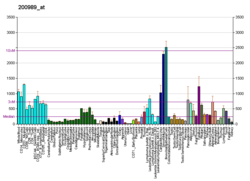Hypoxia-inducible factor 1-alpha, also known as HIF-1-alpha, is a subunit of a heterodimeric transcription factor hypoxia-inducible factor 1 (HIF-1) that is encoded by the HIF1A gene.[5][6][7] The Nobel Prize in Physiology or Medicine 2019 was awarded for the discovery of HIF.
HIF1A is a basic helix-loop-helix PAS domain containing protein, and is considered as the master transcriptional regulator of cellular and developmental response to hypoxia.[8][9] The dysregulation and overexpression of HIF1A by either hypoxia or genetic alternations have been heavily implicated in cancer biology, as well as a number of other pathophysiologies, specifically in areas of vascularization and angiogenesis, energy metabolism, cell survival, and tumor invasion.[7][10] The presence of HIF1A in a hypoxic environment is required to push forward normal placental development in early gestation.[11] Two other alternative transcripts encoding different isoforms have been identified.[7]
- ^ a b c GRCh38: Ensembl release 89: ENSG00000100644 – Ensembl, May 2017
- ^ a b c GRCm38: Ensembl release 89: ENSMUSG00000021109 – Ensembl, May 2017
- ^ "Human PubMed Reference:". National Center for Biotechnology Information, U.S. National Library of Medicine.
- ^ "Mouse PubMed Reference:". National Center for Biotechnology Information, U.S. National Library of Medicine.
- ^ Semenza GL, Rue EA, Iyer NV, Pang MG, Kearns WG (June 1996). "Assignment of the hypoxia-inducible factor 1alpha gene to a region of conserved synteny on mouse chromosome 12 and human chromosome 14q". Genomics. 34 (3): 437–9. doi:10.1006/geno.1996.0311. PMID 8786149.
- ^ Hogenesch JB, Chan WK, Jackiw VH, Brown RC, Gu YZ, Pray-Grant M, et al. (March 1997). "Characterization of a subset of the basic-helix-loop-helix-PAS superfamily that interacts with components of the dioxin signaling pathway". The Journal of Biological Chemistry. 272 (13): 8581–93. doi:10.1074/jbc.272.13.8581. PMID 9079689. S2CID 14908247.
- ^ a b c "Entrez Gene: HIF1A hypoxia-inducible factor 1, alpha subunit (basic helix-loop-helix transcription factor)".
- ^ Wang GL, Jiang BH, Rue EA, Semenza GL (June 1995). "Hypoxia-inducible factor 1 is a basic-helix-loop-helix-PAS heterodimer regulated by cellular O2 tension". Proceedings of the National Academy of Sciences of the United States of America. 92 (12): 5510–4. Bibcode:1995PNAS...92.5510W. doi:10.1073/pnas.92.12.5510. PMC 41725. PMID 7539918.
- ^ Iyer NV, Kotch LE, Agani F, Leung SW, Laughner E, Wenger RH, et al. (January 1998). "Cellular and developmental control of O2 homeostasis by hypoxia-inducible factor 1 alpha". Genes & Development. 12 (2): 149–62. doi:10.1101/gad.12.2.149. PMC 316445. PMID 9436976.
- ^ Semenza GL (October 2003). "Targeting HIF-1 for cancer therapy". Nature Reviews. Cancer. 3 (10): 721–32. doi:10.1038/nrc1187. PMID 13130303. S2CID 2448376.
- ^ Soares MJ, Iqbal K, Kozai K (October 2017). "Hypoxia and Placental Development". Birth Defects Research. 109 (17): 1309–1329. doi:10.1002/bdr2.1135. PMC 5743230. PMID 29105383.





